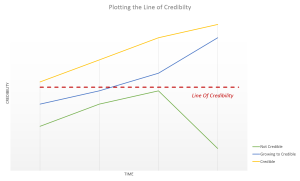Line Of Credibility
Have you ever thought that a low risk tolerance and fear of failure within your company is stifling your creativity and ability to do great things?
Reading Bold: How to Go Big, Create Wealth and Impact the World by Peter H. Diamandis and Steven Kotler. They articulated an interesting concept. It is the idea that sometimes, you must start an idea above the line of credibility. The line of credibility exists in each our our minds. When you
by Peter H. Diamandis and Steven Kotler. They articulated an interesting concept. It is the idea that sometimes, you must start an idea above the line of credibility. The line of credibility exists in each our our minds. When you  first hear an idea, if it seems too outrageous most people will place it below the line of credibility, dismissing it as impossible, crazy, etc. Unfortunately, after a few of
first hear an idea, if it seems too outrageous most people will place it below the line of credibility, dismissing it as impossible, crazy, etc. Unfortunately, after a few of
these ‘crazy ideas’ they also dismiss the presenter and being dismissed as the ‘crazy idea guy’ will not further your position in the department or career.
 first hear an idea, if it seems too outrageous most people will place it below the line of credibility, dismissing it as impossible, crazy, etc. Unfortunately, after a few of
first hear an idea, if it seems too outrageous most people will place it below the line of credibility, dismissing it as impossible, crazy, etc. Unfortunately, after a few ofthese ‘crazy ideas’ they also dismiss the presenter and being dismissed as the ‘crazy idea guy’ will not further your position in the department or career.
For an idea to gain mind share and traction it must be above the line of credibility. It must look plausible. The mind’s immediate response needs to be at least, ‘okay, that makes sense.’ Diamandis goes on to highlight that big, bold ideas have a higher bar, the Line of Super-Credibility. In this case, the idea is so convincing, your mind accept it immediately and are thinking, “Fantastic! How do I get involved?” I know many corporate environments require that same level of Super-Credibility to get anything off the ground.
How do we start above the Line of Credibility or Super-Credibility?
- Familiarity matters. Start by sharing the idea with people you have successfully worked with before. We all have a small group of individuals we trust, because we know how they operate. Leverage this and recruit those people to your cause.
- Slow down and build credibility. Another way of saying start small. Start with a goal that is imminently achievable. Your big ideas will come much faster if you slow down, start small build build momentum in execution. After all, most people love to cheer for great ideas but we only invest money in execution.
- Messaging Matters. Two parts to this: how you articulate the big idea and plans to achieve it, 2. How the message is delivered.
- First, you need to map out the details of your plans to achieve your grand scheme, big idea. No detail is too small because someone will ask you and being able to answer confidently is critical to credibility. If you’re not confident, why would they be?
- Second, how your message is delivered makes all the difference in the world. Envision this, you’ve recruited the best advisors you have. The smartest, most respected people in your department or company and have them on board. What if they deliver your messaging? What if someone from the finance department walks through the finances? Your colleague from Marketing shares the marketing strategy? How will that come across to your audience? With this approach, you are serving two goals. Primarily, your audience will obviously have a much more credible perception of the ideas. Secondarily, your co-presenters will be more committed to your idea than ever before.
Your big idea needs to speak both the emotions and logic of the audience. It should stir some emotions, otherwise, it’s not big enough to move the needle. By slowing down and building credibility, i.e. starting small, you have broken the idea into subgoals, which are imminently achievable. This caters to the logical brain, the critical mind that wants to avoid risk and lets them say yes to the next bite size step of the project

